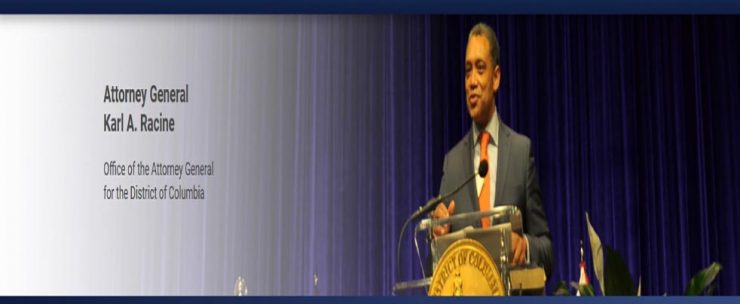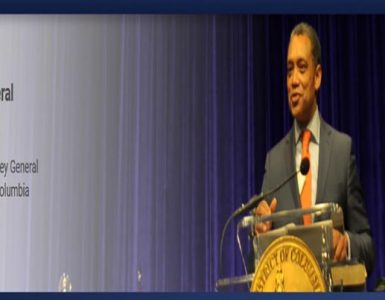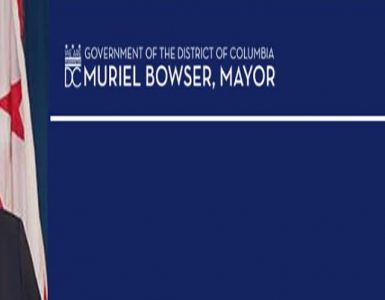August 13, 2019
Coalition Claims Trump Admin Rule Violates Clean Air Act While Promoting Dirty, Expensive Coal Power and Undercutting Clean, Renewable, and Affordable Energy
WASHINGTON, D.C. – Attorney General Karl A. Racine joined a coalition of 22 states and 7 local governments in announcing a lawsuit against the Trump Administration’s recently released“ACE” – aka “Dirty Power” – rule. The ACE rule is intended to replace the Clean Power Plan, the first-ever nationwide limits on one of the largest sources of climate change pollution: existing fossil-fueled power plants. The EPA’s rule rolls back these limits and will have virtually no impact on these emissions, prolonging the nation’s reliance on polluting, expensive coal power plants and obstructing progress of states toward clean, renewable, and affordable electricity generation.
Without immediate federal action to substantially reduce GHG emissions – which the ACE rule wholly fails to do – the District will face severe climate harms. As a densely populated area located at the confluence of two tidal rivers, the District is particularly vulnerable to the effects of climate change caused in large part by GHG emissions, including dangerous heat waves, flooding caused by rising tides and heavy rains, and severe weather. By 2080, the U.S. Army Corps of Engineers predicts up to 3.4 feet of additional sea level rise in DC. Average temperatures in the District have already increased and heat emergencies are projected to increase to 30-45 days by the 2050s, and 40-75 days by the 2080s. EPA should protect District residents from these harms, not protect the profits of coal-fired power plant operators.
Clean Air Act Requirements
Besides ignoring the science of climate change – the text of the ACE rule barely mentions climate change, much less recognize the dire threat it poses to people’s health, the economy, and the environment – the rule disregards requirements of the federal Clean Air Act. The Clean Air Act requires that limits on air pollutants, such as greenhouse gases, must be based on the emissions reductions achievable through the “best system of emission reduction.” However, in the “Dirty Power” rule, EPA has ruled out as such a “best system” the most cost-effective, proven, and successful approach to controlling greenhouse gas emissions: shifting from coal-fueled generation to less carbon-intensive generation.
Unlike the Clean Power Plan, which was modeled after successful state programs that require cleaner energy generation, the ACE rule turns a blind eye to these programs. For example, the 10-state (New York, Connecticut, Delaware, Maine, Maryland, Massachusetts, New Jersey, Rhode Island, and Vermont) Regional Greenhouse Gas Initiative (RGGI), a market-based cap-and-trade program, has proven to be an effective, cost-efficient model for reducing power plant emissions of climate change pollution. Power plants in the participating RGGI states have cut their emissions by more than 50 percent, and between 2015 and 2017, these states saw $1.4 billion of net positive economic activity and the creation of 14,500 new jobs – all while maintaining the reliability of service and holding the line on electricity rates.
In fact, the “Dirty Power” rule goes so far as to prohibit states from participating in cap-and-trade programs means of complying with the requirements of the Clean Air Act.
“Dirty Power Rule” Fails to Achieve Meaningful Emission Reduction
Significantly, the “best system of emission reduction” used by the Trump EPA in the “Dirty Power” rule –efficiency improvements at coal power plants – will reduce emissions by only 0.7 percent more by 2030 than having no rule at all, according to EPA’s own analysis. Further, EPA found that emissions of one or more of three pollutants – carbon dioxide (CO2), nitrogen oxides (NOx), and sulfur dioxide (SO2) – will increase in 18 states in 2030 compared to no “Dirty Power” rule.
The differences in benefits provided by the Clean Power Plan compared to the Trump “Dirty Power” rule are substantial, as reflected in the table below using the agency’s own calculations when it finalized the two rules:
| “Dirty Power” Rule
(ACE Rule) |
Clean Power Plan | |
| Pollutant Reductions by 2030 | ||
| CO2 (million tons) | 11
(0.7%) |
415
(19%) |
| SO2 (thousand tons) | 5.7
(0.6%) |
318
(24%) |
| NOx (thousand tons) | 7.1
(0.9%) |
282
(22%) |
| Benefits by 2030 ($ millions)* | 570-1,300 | 34,000-54,000 |
| Costs by 2030 ($ millions)* | 280 | 8,400 |
| Net Benefits by 2030
($ millions)* |
300-1,000 | 26,000-45,000 |
* 3% Discount Rate; ACE rule in 2016 dollars and Clean Power Plan in 2011 dollars. Sources: Regulatory Impact Analysis for the Repeal of the Clean Power Plan, and the Emission Guidelines for Greenhouse Gas Emissions from Existing Electric Utility Generating Units, EPA-452/R-19-003 (June 2019); Regulatory Impact Analysis for the Clean Power Plan Final Rule, EPA-452/R-15-003 (August 2015).
The implications of the “Dirty Power” rule’s failure to achieve virtually any reductions in power plant emissions are extensive. The International Energy Agency estimates that climate change pollution from the U.S. power sector must be reduced by 74 percent by 2030 below 2005 levels for the U.S. to be able to achieve the goal of limiting worldwide temperature increase to less than 2 degrees Celsius. By the EPA’s own estimates, the “Dirty Power” rule falls woefully short of hitting this target with a projected reduction of only 35 percent from 2005 levels. Of that, only roughly one percent is attributable to the impact of the “Dirty Power” rule and 34 percent attributable to market factors.
Today’s suit was filed in the US Court of Appeals for the District of Columbia Circuit. In addition to Attorney General AG Racine, the suit, led by New York Attorney General Letitia James, is joined by the Attorneys General of California, Colorado, Connecticut, Delaware, Hawaii, Illinois, Maine, Maryland, Massachusetts, Michigan, Minnesota, New Jersey, New Mexico, North Carolina, Oregon, Pennsylvania, Rhode Island, Vermont, Virginia, Washington, Wisconsin, and the District of Columbia, and the chief legal officers of Boulder, Chicago, Los Angeles, New York City, Philadelphia, and South Miami.
Past Actions to Defend the Clean Power Plan
This is not the first time that Attorney General Racine has joined with other states and localities to defend the Clean Power Plan. He joined with a coalition that sought to intervene and defend the Clean Power Plan from a legal challenge in 2016, and spoke out against President Trump’s March 2017 executive order, which was described as laying the groundwork to eliminating the Clean Power Plan. AG Racine also joined with others to urge the retraction of “legally incorrect” guidance from EPA to states regarding Clean Power Plan implementation and deadlines, and to urge the recusal of EPA Administrator Scott Pruitt from the Clean Power Plan repeal decision. In March 2018, AG Racine joined a coalition to file comments opposing the Trump Administration’s Advance Notice of Proposed Rulemaking on a “potential” replacement to the Clean Power Plan.
Previous Article
Content retrieved from: https://oag.dc.gov/release/ag-racine-joins-lawsuit-against-trumps-dirty-power.


















Add comment